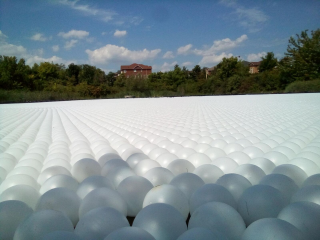Evaluation of shade balls for mitigating summer heating of stormwater management ponds
 While detaining stormwater in ponds is an effective way to improve water quality, it also causes warming during summer months, primarily due to solar radiation of stored water during the inter-event period. As this warmer water is discharged from the pond into receiving streams, it can adversely impact aquatic life, as several species are sensitive to even small temperature changes.
While detaining stormwater in ponds is an effective way to improve water quality, it also causes warming during summer months, primarily due to solar radiation of stored water during the inter-event period. As this warmer water is discharged from the pond into receiving streams, it can adversely impact aquatic life, as several species are sensitive to even small temperature changes.
In an effort to mitigate these thermal impacts, several practices have been developed and applied in Ontario, such as the construction of deeper ponds with subsurface draw outlets. Although deep ponds with subsurface draw structures are technically simple to apply, they are not always feasible and can significantly increase long term maintenance costs for municipalities. For this reason, lower maintenance, cost-effective alternative measures are being piloted and evaluated to determine whether they can help achieve provincial stormwater temperature targets.
This study pilots the partial shading of a stormwater pond in the City of Brampton using shade balls, and evaluates the effectiveness of this practice in preventing pond heating during warm summer months. The round shade balls, applied to cover 75% of the pond surface area, are used to prevent solar heating, deter bacterial contamination from birds, and allow heat transfer from the pond to the air at times when air temperatures are cooler than the pond.
Baseline monitoring at the pilot site was initiated in spring 2018 and the shade balls installed in the fall of 2018. Performance monitoring was carried out during the summers of 2019 and 2020, and included temperature monitoring of inflows and outflows and in-pond temperature depth profiles at both the shade ball pond and an experimental control pond also located in Brampton.
